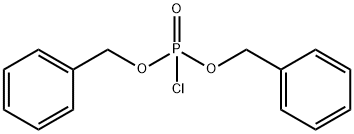DIETHYL CHLOROPHOSPHITE
Synonym(s):Diethyl chlorophosphonite;Diethyl phosphorochloridite
- CAS NO.:589-57-1
- Empirical Formula: C4H10ClO2P
- Molecular Weight: 156.55
- MDL number: MFCD00009074
- EINECS: 209-652-2
- SAFETY DATA SHEET (SDS)
- Update Date: 2025-08-13 11:09:07

What is DIETHYL CHLOROPHOSPHITE?
Chemical properties
clear colorless to yellow liquid
The Uses of DIETHYL CHLOROPHOSPHITE
Diethyl Chlorophosphite is used in the synthesis of organophosphates and are considered anticholinesterase agents through observation in studies.
The Uses of DIETHYL CHLOROPHOSPHITE
In peptide synthesis.
The Uses of DIETHYL CHLOROPHOSPHITE
Diethyl chlorophosphite acts as a versatile phosphorylating agent for ester and lactone enolates, amines and alkenols. It is used in the synthesis of organophosphates and are considered anticholinesterase agents through observation in studies.
Properties of DIETHYL CHLOROPHOSPHITE
| Melting point: | 25°C |
| Boiling point: | 153-155 °C (lit.)
56-57.5 °C/30 mmHg (lit.) |
| Density | 1.089 g/mL at 20 °C (lit.) |
| refractive index | n |
| Flash point: | 34 °F |
| storage temp. | 2-8°C |
| solubility | Chloroform (Slightly), Ethyl Acetate (Slightly) |
| form | Liquid |
| color | Clear colorless to yellow |
| Water Solubility | Soluble in DMSO and chloroform. Reacts with water. |
| Sensitive | Moisture Sensitive |
| Merck | 14,3841 |
| BRN | 1098392 |
| Stability: | Air and Moisture Sensitive |
| CAS DataBase Reference | 589-57-1(CAS DataBase Reference) |
| EPA Substance Registry System | Phosphorochloridous acid, diethyl ester (589-57-1) |
Safety information for DIETHYL CHLOROPHOSPHITE
| Signal word | Danger |
| Pictogram(s) |
 Flame Flammables GHS02  Corrosion Corrosives GHS05  Exclamation Mark Irritant GHS07 |
| GHS Hazard Statements |
H225:Flammable liquids H314:Skin corrosion/irritation H335:Specific target organ toxicity, single exposure;Respiratory tract irritation |
| Precautionary Statement Codes |
P210:Keep away from heat/sparks/open flames/hot surfaces. — No smoking. P233:Keep container tightly closed. P240:Ground/bond container and receiving equipment. P280:Wear protective gloves/protective clothing/eye protection/face protection. P303+P361+P353:IF ON SKIN (or hair): Remove/Take off Immediately all contaminated clothing. Rinse SKIN with water/shower. P305+P351+P338:IF IN EYES: Rinse cautiously with water for several minutes. Remove contact lenses, if present and easy to do. Continuerinsing. |
Computed Descriptors for DIETHYL CHLOROPHOSPHITE
DIETHYL CHLOROPHOSPHITE manufacturer
NSR Amino Organics
1Y
Phone:+91-9866989891
Whatsapp: +91-9866989891
product: Diethyl Chlorophosphite 589-57-1 98%
New Products
Indole Methyl Resin tert-butyl 9-methoxy-3-azaspiro[5.5]undecane-3-carboxylate Boc-His(Boc)-OH 2-CTC Resin 4-Chloro-7-tosy1-7Hpyrrolo[2,3-d]pyrimidine 5,7-Dibromo-1H-indole 2,5-dichloro-N-hydroxy-4,6-dimethylpyridine-3-carboximidamide 2,2-Dimethoxy-7-azaspiro[3.5]nonane hydrochloride 4-chloromethyl-5-methyl-1,3-dioxol-2-one (DMDO-Cl) R-2-BENZYLOXY PROPIONIC ACID 1,1’-CARBONYLDIIMIDAZOLE 1,1’-CARBONYLDI (1,2-4 TRIAZOLE) N-METHYL INDAZOLE-3-CARBOXYLIC ACID 4-((2-hydroxyethyl)thio)benzoic acid 1-(TERT-BUTOXYCARBONYL)-2-PYRROLIDINONE Methyl 6-methylnicotinate 3-Pyridineacrylic acid tert-Butyl carbazate TETRAHYDRO-2H-PYRAN-3-OL 2-((4-morpholinophenylamino) (methylthio) methylene) malononitrile 3-(4-morpholinophenylamino)-5-amino-1H-pyrazole-4-carbonitrile 2,4-dihydroxybenzaldehyde 1,3-Diethyl-1,3-Diphenylurea Methyl 2-methylquinoline-6-carboxylateRelated products of tetrahydrofuran


![BIS[2-(P-NITROPHENYL)ETHYL] PHOSPHOROCHLORIDATE](https://img.chemicalbook.in/CAS/GIF/85363-77-5.gif)





You may like
-
 Diethyl chlorophosphite CAS 589-57-1View Details
Diethyl chlorophosphite CAS 589-57-1View Details
589-57-1 -
 Diethyl chlorophosphite CAS 589-57-1View Details
Diethyl chlorophosphite CAS 589-57-1View Details
589-57-1 -
 Diethyl Chlorophosphite 589-57-1 98%View Details
Diethyl Chlorophosphite 589-57-1 98%View Details
589-57-1 -
 Pyridine 99.5% HPLC /UV SpectroscopyView Details
Pyridine 99.5% HPLC /UV SpectroscopyView Details
110-86-1 -
 Piperazine Spot supply, best priceView Details
Piperazine Spot supply, best priceView Details
110-85-0 -
 Dibutyl PhthalateView Details
Dibutyl PhthalateView Details
84-74-2 -
 Imidazole Spot supply, competitive priceView Details
Imidazole Spot supply, competitive priceView Details
288-32-4 -
 Thiourea 99% ARView Details
Thiourea 99% ARView Details
62-56-6
Statement: All products displayed on this website are only used for non medical purposes such as industrial applications or scientific research, and cannot be used for clinical diagnosis or treatment of humans or animals. They are not medicinal or edible.
